苹果公司英文简介
- 格式:doc
- 大小:16.00 KB
- 文档页数:1

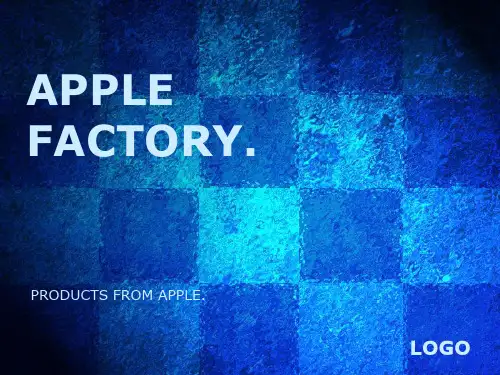
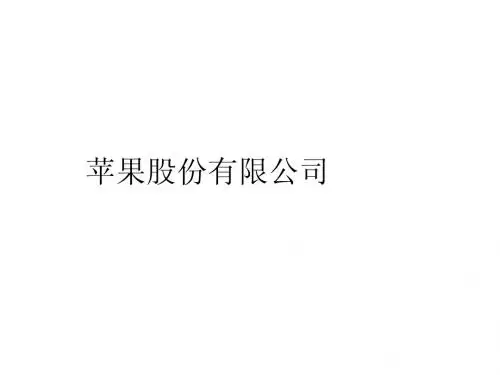
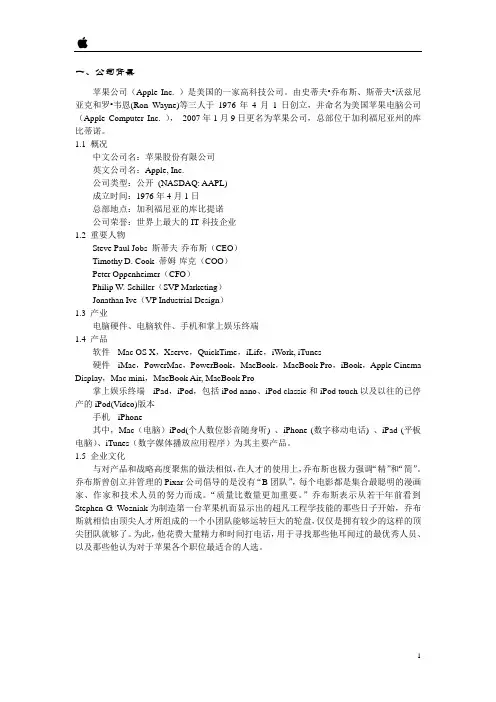
一、公司背景苹果公司(Apple Inc. )是美国的一家高科技公司。
由史蒂夫•乔布斯、斯蒂夫•沃兹尼亚克和罗•韦恩(Ron Wayne)等三人于1976年4月1日创立,并命名为美国苹果电脑公司(Apple Computer Inc. ),2007年1月9日更名为苹果公司,总部位于加利福尼亚州的库比蒂诺。
1.1 概况中文公司名:苹果股份有限公司英文公司名:Apple, Inc.公司类型:公开(NASDAQ: AAPL)成立时间:1976年4月1日总部地点:加利福尼亚的库比提诺公司荣誉:世界上最大的IT科技企业1.2 重要人物Steve Paul Jobs 斯蒂夫·乔布斯(CEO)Timothy D. Cook 蒂姆·库克(COO)Peter Oppenheimer(CFO)Philip W. Schiller(SVP Marketing)Jonathan Ive(VP Industrial Design)1.3 产业电脑硬件、电脑软件、手机和掌上娱乐终端1.4 产品软件-- Mac OS X,Xserve,QuickTime,iLife,iWork, iTunes硬件-- iMac,PowerMac,PowerBook,MacBook,MacBook Pro,iBook,Apple Cinema Display,Mac mini,MacBook Air, MacBook Pro掌上娱乐终端-- iPad,iPod,包括iPod nano、iPod classic和iPod touch以及以往的已停产的iPod(Video)版本手机-- iPhone其中,Mac(电脑)iPod(个人数位影音随身听) 、iPhone (数字移动电话) 、iPad (平板电脑)、iTunes(数字媒体播放应用程序)为其主要产品。
1.5 企业文化与对产品和战略高度聚焦的做法相似,在人才的使用上,乔布斯也极力强调“精”和“简”。
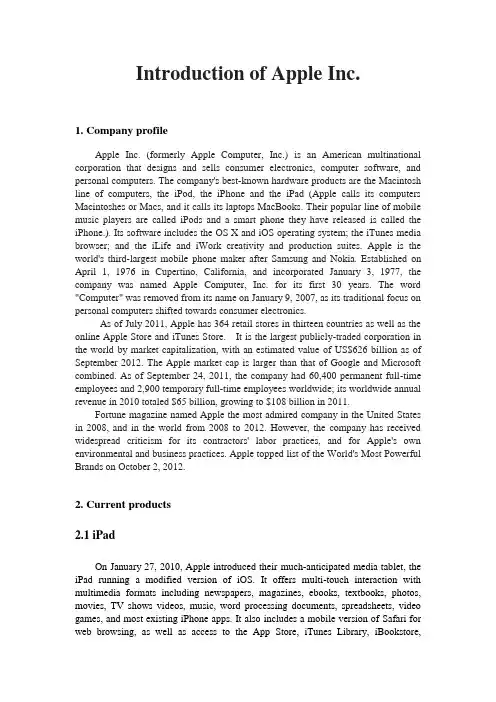
Introduction of Apple Inc.1. Company profileApple Inc. (formerly Apple Computer, Inc.) is an American multinational corporation that designs and sells consumer electronics, computer software, and personal computers. The company's best-known hardware products are the Macintosh line of computers, the iPod, the iPhone and the iPad (Apple calls its computers Macintoshes or Macs, and it calls its laptops MacBooks. Their popular line of mobile music players are called iPods and a smart phone they have released is called the iPhone.). Its software includes the OS X and iOS operating system; the iTunes media browser; and the iLife and iWork creativity and production suites. Apple is the world's third-largest mobile phone maker after Samsung and Nokia. Established on April 1, 1976 in Cupertino, California, and incorporated January 3, 1977, the company was named Apple Computer, Inc. for its first 30 years. The word "Computer" was removed from its name on January 9, 2007, as its traditional focus on personal computers shifted towards consumer electronics.As of July 2011, Apple has 364 retail stores in thirteen countries as well as the online Apple Store and iTunes Store. It is the largest publicly-traded corporation in the world by market capitalization, with an estimated value of US$626 billion as of September 2012. The Apple market cap is larger than that of Google and Microsoft combined. As of September 24, 2011, the company had 60,400 permanent full-time employees and 2,900 temporary full-time employees worldwide; its worldwide annual revenue in 2010 totaled $65 billion, growing to $108 billion in 2011.Fortune magazine named Apple the most admired company in the United States in 2008, and in the world from 2008 to 2012. However, the company has received widespread criticism for its contractors' labor practices, and for Apple's own environmental and business practices. Apple topped list of the World's Most Powerful Brands on October 2, 2012.2. Current products2.1 iPadOn January 27, 2010, Apple introduced their much-anticipated media tablet, the iPad running a modified version of iOS. It offers multi-touch interaction with multimedia formats including newspapers, magazines, ebooks, textbooks, photos, movies, TV shows videos, music, word processing documents, spreadsheets, video games, and most existing iPhone apps. It also includes a mobile version of Safari for web browsing, as well as access to the App Store, iTunes Library, iBookstore,contacts, and notepad. Content is downloadable via Wi-Fi and optional 3G service or synced through the user's computer. AT&T was initially the sole US provider of 3G wireless access for the iPad.On March 2, 2011, Apple introduced an updated iPad model which had a faster processor and two cameras on the front and back respectively. The iPad 2 also added support for optional 3G service provided by Verizon in addition to the existing offering by AT&T. However, the availability of the iPad 2 has been limited as a result of the devastating earthquake and ensuing tsunami in Japan in March 2011.On March 7, 2012, Apple introduced the third generation iPad (dubbed "the new iPad" by Apple). The third-generation iPad added LTE service from AT&T or Verizon and an upgraded processor, the A5X. It also added the Retina display (2048 by 1536 resolution), originally implemented on the iPhone 4 and iPhone 4S. The dimensions and form factor remained relatively unchanged, with the new iPad being a fraction thicker and heavier than the previous version, and minor positioning changes.Since the tablet launched in 2010, iPad users have downloaded 3 billion apps, while the total App Store downloads is up to over 25 billion downloads.2.2 iPodThe current iPod family, featuring the iPod Shuffle, iPod Nano, iPod Classic, and iPod TouchOn October 23, 2001, Apple introduced the iPod digital music player. It has evolved to include various models targeting the wants of different users. The iPod is the market leader in portable music players by a significant margin, with more than 220 million units shipped as of September 2009[update]. Apple has partnered with Nike to offer the Nike+iPod Sports Kit enabling runners to synchronize and monitor their runs with iTunes and the Nike+ website. Apple currently sells four variants of the iPod.•iPod Shuffle, ultraportable digital audio player first introduced in 2005, currently available in a 2 GB model.•iPod Nano, portable media player first introduced in 2005, currently available in 8 and 16 GB models. The latest generation has a FM radio, a pedometer,and a new multi-touch interface that replaced the traditional iPod click wheel.•iPod Classic (previously named iPod from 2001 to 2007), portable media player first introduced in 2001, currently available in a 160 GB model.•iPod Touch, portable media player that runs iOS, first introduced in September 2007 after the iPhone went on sale. Currently available in 8, 32, and 64 GBmodels. The latest generation features the Apple A4 processor, a RetinaDisplay, and dual cameras on the front and back. The back camera allows forHD video recording at 720p.2.3 iPhoneOn October 4, 2011, Apple unveiled the iPhone 4S, which was released in the United States, Canada, Australia, United Kingdom, France, Germany, and Japan on October 14, 2011, with other countries set to follow later in the year. This was the first iPhone model to feature the Apple A5 chip, as well as the first offered on the Sprint network (joining AT&T and Verizon Wireless as the United States carriers offering iPhone models). On October 19, 2011, Apple announced an agreement with C Spire Wireless to sell the iPhone 4S with that carrier in the near future, marking the first time the iPhone was officially supported on a regional carrier's network.Another notable feature of the iPhone 4S was Siri voice assistant technology, which Apple had acquired in 2010, as well as other features, including an updated 8 megapixel camera with new optics. Apple sold 4 million iPhone 4S phones in the first three days after its release, which made it not only the best iPhone launch in Apple's history, but the most successful launch of any mobile phone ever. On Wednesday September 12, 2012, Apple's sixth edition iPhone, the iPhone 5 was announced. It featured a bigger screen, 4G LTE connectivity, and a new Apple A6 chip among many other improvements. Apple sold two million iPhone's in the first twenty four hours of pre ordering.2.4 Apple TVAt the 2007 Macworld conference, Jobs demonstrated the Apple TV, (previously known as the iTV), a set-top video device intended to bridge the sale of content from iTunes with high-definition televisions. The device links up to a user's TV and syncs, either via Wi-Fi or a wired network, with one computer's iTunes library and streams from an additional four. The Apple TV originally incorporated a 40 GB hard drive for storage, includes outputs for HDMI and component video, and plays video at a maximum resolution of 720p. On May 31, 2007 a 160 GB drive was released alongside the existing 40 GB model and on January 15, 2008 a software update was released, which allowed media to be purchased directly from the Apple TV. In September 2009, Apple discontinued the original 40 GB Apple TV and now continues to produce and sell the 160 GB Apple TV. On September 1, 2010, alongside the release of the new line of iPod devices for the year, Apple released a completely redesigned Apple TV. The new device is 1/4 the size, runs quieter, and replaces the need for a hard drive with media streaming from any iTunes library on the network along with 8 GB of flash memory to cache media downloaded. Apple with the Apple TV has added another device to its portfolio that runs on its A4 processor along with the iPad and the iPhone. The memory included in the device is the half of the iPhone4 at 256 MB; the same as the iPad, iPhone 3GS, iPod touch 3G, and iPod touch 4G. It has HDMI out as the only video out source. Features include access to the iTunes Store to rent movies and TV shows (purchasing has been discontinued), streaming from internet video sources, including YouTube and Netflix, and media streaming from an iTunes library. Apple also reduced the price of the device to $99. A third generation of the device was introduced at an Apple event on March 7, 2012, with new features such as higher resolution (1080p) and a new user interface.3. MarketingApple aficionados wait in line around an Apple retail store in anticipation of a new product. This branch is located on Fifth Avenue in New York City, with a glass cube housing a cylindrical elevator and a spiral staircase that lead into the subterranean store.Apple' brand and brand community. Apple's brand's loyalty is considered unusual for any product. At one time, Apple evangelists were actively engaged by the company, but this was after the phenomenon was already firmly established. Apple evangelist Guy Kawasaki has called the brand fanaticism “something that was stumbled upon”. Apple has, however, supported the continuing existence of a network of Mac User Groups in most major and many minor centers of population where Mac computers are available.Mac users would meet at the European Apple Expo and the San Francisco Macworld Conference & Expo trade shows where Apple traditionally introduced new products each year to the industry and public until Apple pulled out of both events. While the conferences continue, Apple does not have official representation there. Mac developers, in turn, continue to gather at the annual Apple Worldwide Developers Conference.Apple Store openings can draw crowds of thousands, with some waiting in line as much as a day before the opening or flying in from other countries for the event. The New York City Fifth Avenue “Cube” store had a line as long as half a mile; a few Mac fans took the opportunity of the setting to propose marriage. The Ginza opening in Tokyo was estimated in the thousands with a line exceeding eight city blocks.John Sculley told The Guardian newspaper in 1997: “People talk about technology, but Apple was a marketing company. It was the marketing company of the decade.”Research in 2002 by NetRatings indicates that the average Apple consumer was usually more affluent and better educated than other PC company consumers. The research indicated that this correlation could stem from the fact that on average Apple Inc. products are more expensive than other PC products.3.1 NameAccording to Steve Jobs, Apple was so named because Jobs was coming back from an apple farm, and he was on a fruitarian diet. He thought the name was “fun, spirited and not intimidating”.3.2 LogosThe original logo with Isaac Newton under an apple treeThe rainbow “bitten” logo, used from late 1976 to 1998The monochrome logo, used since 1998Apple's first logo, designed by Ron Wayne, depicts Sir Isaac Newton sitting under an apple tree.Almost immediately, though, this was replaced by Rob Janoff's “rainbow Apple”, the now-familiar rainbow-colored silhouette of an apple with a bite taken out of it. Janoff presented Jobs with several different monochromatic themes for the “bitten”logo, and Jobs immediately took a liking to it. While Jobs liked the logo, he insisted it be in color to humanize the company. The Apple logo was designed with a bite so that it would not be recognized as another fruit. The colored stripes were conceived tomake the logo more accessible, and to represent the fact the Apple II could generate graphics in color.This logo is often erroneously referred to as a tribute to Alan Turing, with the bite mark a reference to his method of suicide. Both the designer of the logo and the company deny that there is any homage to Turing in the design of the logo.In 1998, with the roll-out of the new iMac, Apple discontinued the rainbow theme and began to use monochromatic themes, nearly identical in shape to its previous rainbow incarnation, on various products, packaging and advertising. An Aqua-themed version of the monochrome logo was used from 2001–2003, and a Glass-themed version has been used since 2003.Steve Jobs and Steve Wozniak were Beatles fans, but Apple Inc. had trademark issues with Apple Corps Ltd., a multimedia company started by The Beatles in 1967, involving their name and logo. This resulted in a series of lawsuits and tension between the two companies. These issues ended with settling of their most recent lawsuit in 2007.3.3 SlogansApple's first slogan, “Byte into an Apple”, was coined in the late 1970s. From 1997–2002, Apple used the slogan “Think Different”in advertising campaigns. Although the slogan has been retired, it is still closely associated with Apple. Apple also has slogans for specific product lines — for example, “iThink, therefore iMac”was used in 1998 to promote the iMac, and “Say hello to iPhone” has been used in iPhone advertisements. “Hello”was also used to introduce the original Macintosh, Newton, iMac (“hello (again)”), and iPod.3.4 AdvertisingSince the introduction of the Macintosh in 1984 with the 1984 Super Bowl commercial to the more modern 'Get a Mac' adverts, Apple has been recognized in the past for its efforts towards effective advertising and marketing for its products, though its advertising has been criticized for the claims of some more recent campaigns, particularly 2005 Power Mac ads and iPhone ads in Britain.Apple's product commercials gained fame for launching musicians into stardom as a result of their eye-popping graphics and catchy tunes. First, the company popularized Canadian singer Feist's “1234”song in its ad campaign. Later, Apple used the song “New Soul“ by French-Israeli singer-songwriter Yael Naïm to promote the MacBook Air.The debut single shot to the top of the charts and sold hundreds of thousands of copies in a span of weeks.4. Corporate affairsDuring the Mac's early history Apple generally refused to adopt prevailing industry standards for hardware, instead creating their own. This trend was largely reversed in the late 1990s beginning with Apple's adoption of the PCI bus in the 7500/8500/9500 Power Macs. Apple has since adopted USB, AGP, HyperTransport,Wi-Fi, and other industry standards in its computers and was in some cases a leader in the adoption of standards such as USB. FireWire is an Apple-originated standard that has seen widespread industry adoption after it was standardized as IEEE 1394.Ever since the first Apple Store opened, Apple has sold third party accessories. For instance, at one point Nikon and Canon digital cameras were sold inside the store. Adobe, one of Apple's oldest software partners, also sells its Mac-compatible software, as does Microsoft, who sells Microsoft Office for the Mac. Books from John Wiley & Sons, who publishes the For Dummies series of instructional books, are a notable exception, however. The publisher's line of books were banned from Apple Stores in 2005 because Steve Jobs disagreed with their decision to publish an unauthorized Jobs biography, iCon.After the launch of the iBookstore, Apple stopped selling physical books, both online and at the Apple Retail Stores.4.1 HeadquartersApple Inc.'s world corporate headquarters are located in the middle of Silicon Valley, at 1–6 Infinite Loop, Cupertino, California. This Apple campus has six buildings that total 850,000 square feet (79,000 m2) and was built in 1993 by Sobrato Development Cos.Apple created subsidiaries in low-tax places such as Ireland, the Netherlands, Luxembourg and the British Virgin Islands to cut the taxes it pays around the world. According to the New York Times, Apple was among the first tech companies to designate overseas salespeople in high-tax countries in a manner that allowed the company to sell on behalf of low-tax subsidiaries on other continents, sidestepping income taxes. Apple was a pioneer of an accounting technique known as the “Double Irish With a Dutch Sandwich,” which reduces taxes by routing profits through Irish subsidiaries and the Netherlands and then to the Caribbean.In 2006, Apple announced its intention to build a second campus on 50 acres (200,000 m2) assembled from various contiguous plots (east of N Wolfe Road between Pruneridge Avenue and Vallco Parkway). Later acquisitions increased this to 175 acres. The new campus, also in Cupertino, will be about 1 mile (1.6 km) east of the current campus. The new campus building will be designed by Norman Foster.On June 7, 2011, Steve Jobs gave a presentation to Cupertino City Council, detailing the architectural design of the new building and its environs. The new campus is planned to house up to 13,000 employees in one central four-storied circular building (with a caféfor 3,000 sitting people integrated) surrounded byextensive landscape (with parking mainly underground and the rest centralized in a parking structure). There will be additional buildings such as an auditorium, R&D facilities, a fitness center and a dedicated generating plant as primary source of electricity (powered by natural gas and other more environmentally sound means).4.2 Corporate cultureApple was one of several highly successful companies founded in the 1970s that bucked the traditional notions of what a corporate culture should look like in organizational hierarchy (flat versus tall, casual versus formal attire, etc.). Other highly successful firms with similar cultural aspects from the same period include Southwest Airlines and Microsoft. Originally, the company stood in opposition to staid competitors like IBM by default, thanks to the influence of its founders; Steve Jobs often walked around the office barefoot even after Apple was a Fortune 500 company. By the time of the “1984”TV ad, this trait had become a key way the company attempted to differentiate itself from its competitors.As the company has grown and been led by a series of chief executives, each with his own idea of what Apple should be, some of its original character has arguably been lost, but Apple still has a reputation for fostering individuality and excellence that reliably draws talented people into its employ, especially after Jobs' return. To recognize the best of its employees, Apple created the Apple Fellows program, awarding individuals who made extraordinary technical or leadership contributions to personal computing while at the company. The Apple Fellowship has so far been awarded to a few individuals including Bill Atkinson, Steve Capps, Rod Holt, Alan Kay, Guy Kawasaki, Al Alcorn, Don Norman, Rich Page, and Steve Wozniak.Numerous employees of Apple have cited that projects without Jobs' involvement often take longer than projects with his involvement. Another presents the image of Jobs “wandering the hall with a flame thrower in hand, asking random people 'do you work on MobileMe?'”.At Apple, employees are specialists who are not exposed to functions outside their area of expertise. Jobs saw this as a means of having best-in-class employees in every role. For instance, Ron Johnson who was Senior Vice President of Retail Operations until November 1, 2011, was responsible for site selection, in-store service, and store layout, yet he had no control of the inventory in his stores (which is done company wide by then-COO and now CEO Tim Cook who has a background in supply-chain management). This is the opposite of General Electric's corporate culture which has created well-rounded managers.Under the leadership of Tim Cook who joined the company in 1998 and ascended to his present position as CEO, Apple has developed an extremely efficient and effective supply chain which has been ranked as the world's best for the fouryears 2007–2010. The company's manufacturing, procurement and logistics enables it to execute massive product launches without having to maintain large, profit-sapping inventories; Apple's profit margins have been 40 percent compared with 10–20 percent for most other hardware companies in 2011. Cook's catchphrase to describe his focus on the company's operational edge is “Nobody wants to buy sour milk”. The company previously advertised its products as being made in America up to the late 1990s, however as a result of outsourcing initiatives in the 2000s almost all of its manufacturing is now done abroad. According to a report by the New York Times, Apple insiders “believe the vast scale of overseas factories as well as the flexibility, diligence and industrial skills of foreign workers have so outpaced their American counterparts that “Made in the U.S.A.” is no longer a viable option for most Apple products”.4.3 FinanceIn its fiscal year ending in September 2011, Apple Inc. hit new heights financially with $108 billion in revenues (increased significantly from $65 billion in 2010) and nearly $82 billion in cash reserves. Apple achieved these results while losing market share in certain product categories.On March 19, 2012, Apple announced plans for a $2.65 per share dividend beginning in fourth quarter of 2012, per approval by their board of directors.On August 20, 2012 Apple closed at a record share price of $665.15. With 936,596,000 outstanding shares (as of June 30, 2012), it had a market capitalization of $622.98 billion. This is the highest nominal market capitalization ever reached by a publicly traded company and surpasses a record set by Microsoft in 1999.。
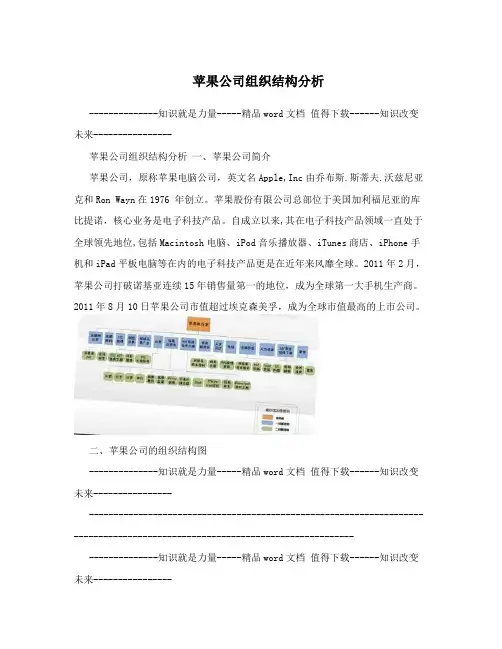
苹果公司组织结构分析--------------知识就是力量-----精品word文档值得下载------知识改变未来----------------苹果公司组织结构分析一、苹果公司简介苹果公司,原称苹果电脑公司,英文名Apple,Inc由乔布斯.斯蒂夫.沃兹尼亚克和Ron Wayn在1976 年创立。
苹果股份有限公司总部位于美国加利福尼亚的库比提诺,核心业务是电子科技产品。
自成立以来,其在电子科技产品领域一直处于全球领先地位,包括Macintosh电脑、iPod音乐播放器、iTunes商店、iPhone手机和iPad平板电脑等在内的电子科技产品更是在近年来风靡全球。
2011年2月,苹果公司打破诺基亚连续15年销售量第一的地位,成为全球第一大手机生产商。
2011年8月10日苹果公司市值超过埃克森美孚,成为全球市值最高的上市公司。
二、苹果公司的组织结构图--------------知识就是力量-----精品word文档值得下载------知识改变未来--------------------------------------------------------------------------------------------------------------------------------------------- --------------知识就是力量-----精品word文档值得下载------知识改变未来----------------APPLE地区组织结构,以便于向全世界的用户生产和配送苹果电脑。
图中所示的部分组织结构说明了APPLE公司的区域性扩展。
APPLE公司用这种结构将管理者和员工集中在专门的区域性消费者和消费目标上。
区域分部式结构使组织能适应各自地区的特殊要求。
雇员按照区域性目标而非国家性目标来分派,强调区域内的协调,而不是跨地区协调或全国总部的关系。
三、苹果公司组织结构设置原则1、简约不简单,精简机构简约是苹果组织结构的关键。
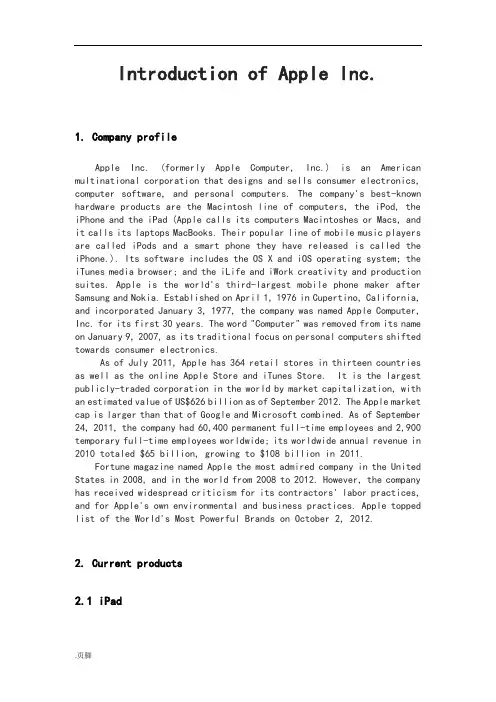
Introduction of Apple Inc.1. Company profileApple Inc. (formerly Apple Computer, Inc.) is an American multinational corporation that designs and sells consumer electronics, computer software, and personal computers. The company's best-known hardware products are the Macintosh line of computers, the iPod, the iPhone and the iPad (Apple calls its computers Macintoshes or Macs, and it calls its laptops MacBooks. Their popular line of mobile music players are called iPods and a smart phone they have released is called the iPhone.). Its software includes the OS X and iOS operating system; the iTunes media browser; and the iLife and iWork creativity and production suites. Apple is the world's third-largest mobile phone maker after Samsung and Nokia. Established on April 1, 1976 in Cupertino, California, and incorporated January 3, 1977, the company was named Apple Computer, Inc. for its first 30 years. The word "Computer" was removed from its name on January 9, 2007, as its traditional focus on personal computers shifted towards consumer electronics.As of July 2011, Apple has 364 retail stores in thirteen countries as well as the online Apple Store and iTunes Store. It is the largest publicly-traded corporation in the world by market capitalization, with an estimated value of US$626 billion as of September 2012. The Apple market cap is larger than that of Google and Microsoft combined. As of September 24, 2011, the company had 60,400 permanent full-time employees and 2,900 temporary full-time employees worldwide; its worldwide annual revenue in 2010 totaled $65 billion, growing to $108 billion in 2011.Fortune magazine named Apple the most admired company in the United States in 2008, and in the world from 2008 to 2012. However, the company has received widespread criticism for its contractors' labor practices, and for Apple's own environmental and business practices. Apple topped list of the World's Most Powerful Brands on October 2, 2012.2. Current products2.1 iPadOn January 27, 2010, Apple introduced their much-anticipated media tablet, the iPad running a modified version of iOS. It offers multi-touch interaction with multimedia formats including newspapers, magazines, ebooks, textbooks, photos, movies, TV shows videos, music, word processing documents, spreadsheets, video games, and most existing iPhone apps. It also includes a mobile version of Safari for web browsing, as well as access to the App Store, iTunes Library, iBookstore, contacts, and notepad. Content is downloadable via Wi-Fi and optional 3G service or synced through the user's computer. AT&T was initially the sole US provider of 3G wireless access for the iPad.On March 2, 2011, Apple introduced an updated iPad model which had a faster processor and two cameras on the front and back respectively. The iPad 2 also added support for optional 3G service provided by Verizon in addition to the existing offering by AT&T. However, the availability of the iPad 2 has been limited as a result of the devastating earthquake and ensuing tsunami in Japan in March 2011.On March 7, 2012, Apple introduced the third generation iPad (dubbed "the new iPad" by Apple). The third-generation iPad added LTE service from AT&T or Verizon and an upgraded processor, the A5X. It also added the Retina display (2048 by 1536 resolution), originally implemented on the iPhone 4 and iPhone 4S. The dimensions and form factor remained relatively unchanged, with the new iPad being a fraction thicker and heavier than the previous version, and minor positioning changes.Since the tablet launched in 2010, iPad users have downloaded 3 billion apps, while the total App Store downloads is up to over 25 billion downloads.2.2 iPodThe current iPod family, featuring the iPod Shuffle, iPod Nano, iPod Classic, and iPod TouchOn October 23, 2001, Apple introduced the iPod digital music player. It has evolved to include various models targeting the wants of different users. The iPod is the market leader in portable music players by a significant margin, with more than 220 million units shipped as of September 2009[update]. Apple has partnered with Nike to offer the Nike+iPod Sports Kit enabling runners to synchronize and monitor their runs with iTunes and the Nike+ website. Apple currently sells four variants of the iPod.•iPod Shuffle, ultraportable digital audio player first introduced in 2005, currently available in a 2 GB model.•iPod Nano, portable media player first introduced in 2005, currently available in 8 and 16 GB models. The latest generation has a FM radio, a pedometer, and a new multi-touch interface that replaced the traditional iPod click wheel.•iPod Classic (previously named iPod from 2001 to 2007), portable media player first introduced in 2001, currently available in a160 GB model.•iPod Touch, portable media player that runs iOS, first introduced in September 2007 after the iPhone went on sale. Currently available in 8, 32, and 64 GB models. The latest generation features theApple A4 processor, a Retina Display, and dual cameras on the front and back. The back camera allows for HD video recording at 720p.2.3 iPhoneOn October 4, 2011, Apple unveiled the iPhone 4S, which was released in the United States, Canada, Australia, United Kingdom, France, Germany, and Japan on October 14, 2011, with other countries set to follow later in the year. This was the first iPhone model to feature the Apple A5 chip, as well as the first offered on the Sprint network (joining AT&T and Verizon Wireless as the United States carriers offering iPhone models). On October 19, 2011, Apple announced an agreement with C Spire Wireless to sell the iPhone 4S with that carrier in the near future, marking the first time the iPhone was officially supported on a regional carrier's network.Another notable feature of the iPhone 4S was Siri voice assistant technology, which Apple had acquired in 2010, as well as other features, including an updated 8 megapixel camera with new optics. Apple sold 4 million iPhone 4S phones in the first three days after its release, which made it not only the best iPhone launch in Apple's history, but the most successful launch of any mobile phone ever. On Wednesday September 12, 2012, Apple's sixth edition iPhone, the iPhone 5 was announced. It featured a bigger screen, 4G LTE connectivity, and a new Apple A6 chip among many other improvements. Apple sold two million iPhone's in the first twenty four hours of pre ordering.2.4 Apple TVAt the 2007 Macworld conference, Jobs demonstrated the Apple TV, (previously known as the iTV), a set-top video device intended to bridgethe sale of content from iTunes with high-definition televisions. The device links up to a user's TV and syncs, either via Wi-Fi or a wired network, with one computer's iTunes library and streams from an additional four. The Apple TV originally incorporated a 40 GB hard drive for storage, includes outputs for HDMI and component video, and plays video at a maximum resolution of 720p. On May 31, 2007 a 160 GB drive was released alongside the existing 40 GB model and on January 15, 2008 a software update was released, which allowed media to be purchased directly from the Apple TV. In September 2009, Apple discontinued the original 40 GB Apple TV and now continues to produce and sell the 160 GB Apple TV. On September 1, 2010, alongside the release of the new line of iPod devices for the year, Apple released a completely redesigned Apple TV. The new device is 1/4 the size, runs quieter, and replaces the need for a hard drive with media streaming from any iTunes library on the network along with 8 GB of flash memory to cache media downloaded. Apple with the Apple TV has added another device to its portfolio that runs on its A4 processor along with the iPad and the iPhone. The memory included in the device is the half of the iPhone 4 at 256 MB; the same as the iPad, iPhone 3GS, iPod touch 3G, and iPod touch 4G. It has HDMI out as the only video out source. Features include access to the iTunes Store to rent movies and TV shows (purchasing has been discontinued), streaming from internet video sources, including YouTube and Netflix, and media streaming from an iTunes library. Apple also reduced the price of the device to $99. A third generation of the device was introduced at an Apple event on March 7, 2012, with new features such as higher resolution (1080p) and a new user interface.3. MarketingApple aficionados wait in line around an Apple retail store in anticipation of a new product. This branch is located on Fifth Avenue in New York City, with a glass cube housing a cylindrical elevator and a spiral staircase that lead into the subterranean store.Apple' brand and brand community. Apple's brand's loyalty is considered unusual for any product. At one time, Apple evangelists were actively engaged by the company, but this was after the phenomenon was already firmly established. Apple evangelist Guy Kawasaki has called the brand fanaticism “something that was stumbled upon”. Apple has, however, supported the continuing existence of a network of Mac User Groups in most major and many minor centers of population where Mac computers are available.Mac users would meet at the European Apple Expo and the San Francisco Macworld Conference & Expo trade shows where Apple traditionallyintroduced new products each year to the industry and public until Apple pulled out of both events. While the conferences continue, Apple does not have official representation there. Mac developers, in turn, continue to gather at the annual Apple Worldwide Developers Conference.Apple Store openings can draw crowds of thousands, with some waiting in line as much as a day before the opening or flying in from other countries for the event. The New York City Fifth Avenue “Cube” store had a line as long as half a mile; a few Mac fans took the opportunity of the setting to propose marriage. The Ginza opening in Tokyo was estimated in the thousands with a line exceeding eight city blocks.John Sculley told The Guardian newspaper in 1997: “People talk about technology, but Apple was a marketing company. It was the marketing company of the decade.”Research in 2002 by NetRatings indicates that the average Apple consumer was usually more affluent and better educated than other PC company consumers. The research indicated that this correlation could stem from the fact that on average Apple Inc. products are more expensive than other PC products.3.1 NameAccording to Steve Jobs, Apple was so named because Jobs was coming back from an apple farm, and he was on a fruitarian diet. He thought the name was “fun, spirited and not intimidating”.3.2 LogosThe original logo with Isaac Newton under an apple treeThe rainbow “bitten” logo, used from late 1976 to 1998The monochrome logo, used since 1998Apple's first logo, designed by Ron Wayne, depicts Sir Isaac Newton sitting under an apple tree.Almost immediately, though, this was replaced by Rob Janoff's “rainbow Apple”, the now-familiar rainbow-colored silhouette of an apple with a bite taken out of it. Janoff presented Jobs with several different monochromatic themes for the “bitten” logo, and Jobs immediately took a liking to it. While Jobs liked the logo, he insisted it be in color to humanize the company. The Apple logo was designed with a bite so that it would not be recognized as another fruit. The colored stripes were conceived to make the logo more accessible, and to represent the fact the Apple II could generate graphics in color.This logo is often erroneously referred to as a tribute to Alan Turing, with the bite mark a reference to his method of suicide. Both the designer of the logo and the company deny that there is any homage to Turing in the design of the logo.In 1998, with the roll-out of the new iMac, Apple discontinued the rainbow theme and began to use monochromatic themes, nearly identical in shape to its previous rainbow incarnation, on various products, packaging and advertising. An Aqua-themed version of the monochrome logo was used from 2001–2003, and a Glass-themed version has been used since 2003.Steve Jobs and Steve Wozniak were Beatles fans, but Apple Inc. had trademark issues with Apple Corps Ltd., a multimedia company started by The Beatles in 1967, involving their name and logo. This resulted in a series of lawsuits and tension between the two companies. These issues ended with settling of their most recent lawsuit in 2007.3.3 SlogansApple's first slogan, “Byte into an Apple”, was coined in the late 1970s. From 1997–2002, Apple used the slogan “Think Different” in advertising campaigns. Although the slogan has been retired, it is still closely associated with Apple. Apple also has slogans for specific product lines —for example, “iThink, therefore iMac” was used in 1998 to promote the iMac, and “Say hello to iPhone” has been us ed in iPhone advertisements. “Hello” was also used to introduce the original Macintosh, Newton, iMac (“hello (again)”), and iPod.3.4 AdvertisingSince the introduction of the Macintosh in 1984 with the 1984 Super Bowl commercial to the more modern 'Get a Mac' adverts, Apple has been recognized in the past for its efforts towards effective advertising andmarketing for its products, though its advertising has been criticized for the claims of some more recent campaigns, particularly 2005 Power Mac ads and iPhone ads in Britain.Apple's product commercials gained fame for launching musicians into stardom as a result of their eye-popping graphics and catchy tunes. First, the company popularized Canadian singer Feist's “1234” song in its ad campaign. Later, Apple used the song “New Soul“ by French-Israeli singer-songwriter Yael Naïm to promote the MacBook Air.The debut single shot to the top of the charts and sold hundreds of thousands of copies in a span of weeks.4. Corporate affairsDuring the Mac's early history Apple generally refused to adopt prevailing industry standards for hardware, instead creating their own. This trend was largely reversed in the late 1990s beginning with Apple's adoption of the PCI bus in the 7500/8500/9500 Power Macs. Apple has since adopted USB, AGP, HyperTransport,Wi-Fi, and other industry standards in its computers and was in some cases a leader in the adoption of standards such as USB. FireWire is an Apple-originated standard that has seen widespread industry adoption after it was standardized as IEEE 1394.Ever since the first Apple Store opened, Apple has sold third party accessories. For instance, at one point Nikon and Canon digital cameras were sold inside the store. Adobe, one of Apple's oldest software partners, also sells its Mac-compatible software, as does Microsoft, who sells Microsoft Office for the Mac. Books from John Wiley & Sons, who publishes the For Dummies series of instructional books, are a notable exception, however. The publisher's line of books were banned from Apple Stores in 2005 because Steve Jobs disagreed with their decision to publish an unauthorized Jobs biography, iCon.After the launch of the iBookstore, Apple stopped selling physical books, both online and at the Apple Retail Stores.4.1 HeadquartersApple Inc.'s world corporate headquarters are located in the middle of Silicon Valley, at 1–6 Infinite Loop, Cupertino, California. This Apple campus has six buildings that total 850,000 square feet (79,000 m2) and was built in 1993 by Sobrato Development Cos.Apple created subsidiaries in low-tax places such as Ireland, the Netherlands, Luxembourg and the British Virgin Islands to cut the taxes it pays around the world. According to the New York Times, Apple was among the first tech companies to designate overseas salespeople in high-tax countries in a manner that allowed the company to sell on behalf of low-tax subsidiaries on other continents, sidestepping income taxes. Apple was a pioneer of an accounting technique known as the “Double Irish With a Dutch Sandwich,” which reduces taxes by routing profits through Irish subsidiaries and the Netherlands and then to the Caribbean.In 2006, Apple announced its intention to build a second campus on 50 acres (200,000 m2) assembled from various contiguous plots (east of N Wolfe Road between Pruneridge Avenue and Vallco Parkway). Later acquisitions increased this to 175 acres. The new campus, also in Cupertino, will be about 1 mile (1.6 km) east of the current campus. The new campus building will be designed by Norman Foster.On June 7, 2011, Steve Jobs gave a presentation to Cupertino City Council, detailing the architectural design of the new building and its environs. The new campus is planned to house up to 13,000 employees in one central four-storied circula r building (with a café for 3,000 sitting people integrated) surrounded by extensive landscape (with parking mainly underground and the rest centralized in a parking structure). There will be additional buildings such as an auditorium, R&D facilities, a fitness center and a dedicated generating plant as primary source of electricity (powered by natural gas and other more environmentally sound means).4.2 Corporate cultureApple was one of several highly successful companies founded in the 1970s that bucked the traditional notions of what a corporate culture should look like in organizational hierarchy (flat versus tall, casual versus formal attire, etc.). Other highly successful firms with similar cultural aspects from the same period include Southwest Airlines and Microsoft. Originally, the company stood in opposition to staid competitors like IBM by default, thanks to the influence of its founders; Steve Jobs often walked around the office barefoot even after Apple was a Fortune 500 company. By the time of the “1984” TV ad, this trait had become a key way the company attempted to differentiate itself from its competitors.As the company has grown and been led by a series of chief executives, each with his own idea of what Apple should be, some of its original character has arguably been lost, but Apple still has a reputation forfostering individuality and excellence that reliably draws talented people into its employ, especially after Jobs' return. To recognize the best of its employees, Apple created the Apple Fellows program, awarding individuals who made extraordinary technical or leadership contributions to personal computing while at the company. The Apple Fellowship has so far been awarded to a few individuals including Bill Atkinson, Steve Capps, Rod Holt, Alan Kay, Guy Kawasaki, Al Alcorn, Don Norman, Rich Page, and Steve Wozniak.Numerous employees of Apple have cited that projects without Jobs' involvement often take longer than projects with his involvement. Another presents the image of Jobs “wandering the hall with a flame thrower in hand, asking random people 'do you work on MobileMe?'”.At Apple, employees are specialists who are not exposed to functions outside their area of expertise. Jobs saw this as a means of having best-in-class employees in every role. For instance, Ron Johnson who was Senior Vice President of Retail Operations until November 1, 2011, was responsible for site selection, in-store service, and store layout, yet he had no control of the inventory in his stores (which is done company wide by then-COO and now CEO Tim Cook who has a background in supply-chain management). This is the opposite of General Electric's corporate culture which has created well-rounded managers.Under the leadership of Tim Cook who joined the company in 1998 and ascended to his present position as CEO, Apple has developed an extremely efficient and effective supply chain which has been ranked as the world's best for the four years 2007–2010. The company's manufacturing, procurement and logistics enables it to execute massive product launches without having to maintain large, profit-sapping inventories; Apple's profit margins have been 40 percent compared with 10–20 percent for most other hardware companies in 2011. Cook's catchphrase to describe his focus on the company's operational edge is “Nobody wants to buy sour milk”. The company previously advertised its products as being made in America up to the late 1990s, however as a result of outsourcing initiatives in the 2000s almost all of its manufacturing is now done abroad. According to a report by the New York Times, Apple insiders “believe the vast scale of overseas factories as well as the flexibility, diligence and industrial skills of foreign workers have so outpaced their American counterparts that “Made in the U.S.A.” is no longer a viable option for most App le products”.4.3 FinanceIn its fiscal year ending in September 2011, Apple Inc. hit new heights financially with $108 billion in revenues (increased significantly from $65 billion in 2010) and nearly $82 billion in cash reserves. Apple achieved these results while losing market share in certain product categories.On March 19, 2012, Apple announced plans for a $2.65 per share dividend beginning in fourth quarter of 2012, per approval by their board of directors.On August 20, 2012 Apple closed at a record share price of $665.15. With 936,596,000 outstanding shares (as of June 30, 2012), it had a market capitalization of $622.98 billion. This is the highest nominal market capitalization ever reached by a publicly traded company and surpasses a record set by Microsoft in 1999.。
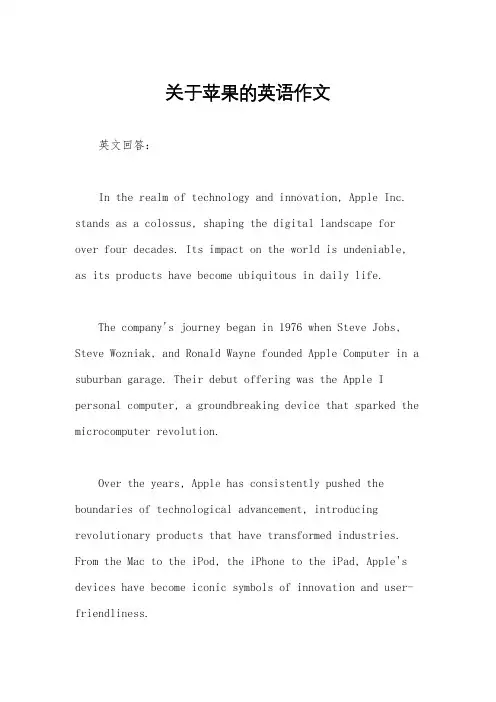
关于苹果的英语作文英文回答:In the realm of technology and innovation, Apple Inc. stands as a colossus, shaping the digital landscape for over four decades. Its impact on the world is undeniable, as its products have become ubiquitous in daily life.The company's journey began in 1976 when Steve Jobs, Steve Wozniak, and Ronald Wayne founded Apple Computer in a suburban garage. Their debut offering was the Apple I personal computer, a groundbreaking device that sparked the microcomputer revolution.Over the years, Apple has consistently pushed the boundaries of technological advancement, introducing revolutionary products that have transformed industries. From the Mac to the iPod, the iPhone to the iPad, Apple's devices have become iconic symbols of innovation and user-friendliness.One of Apple's most significant contributions to the tech industry is the development of the Macintosh operating system. Introduced in 1984, the Mac OS was the first commercially successful graphical user interface (GUI), making computers more accessible and intuitive for the average user.Apple's dedication to design and aesthetics has alsoset it apart from its competitors. Its products are knownfor their sleek, minimalist designs and attention to detail. The company's focus on user experience has resulted in devices that are not only functional but also aesthetically pleasing.Beyond product innovation, Apple has also played a pivotal role in shaping the digital ecosystem. Thecompany's App Store, launched in 2008, has become theworld's largest app marketplace, providing millions of consumers with access to a vast array of software applications.Apple's financial success is a testament to its enduring popularity. In 2022, the company surpassed a market capitalization of $3 trillion, making it the first publicly traded U.S. company to achieve such a milestone.However, Apple's dominance has not come without its share of scrutiny. The company has faced criticism for its closed ecosystem, tax avoidance practices, and allegations of anti-competitive behavior.Despite these challenges, Apple remains a formidable force in the tech industry. Its unwavering commitment to innovation, design, and user experience has secured its place as a global leader in the digital age.中文回答:苹果公司(Apple Inc.)在科技和创新领域堪称巨头,40 多年来一直在塑造数字格局。
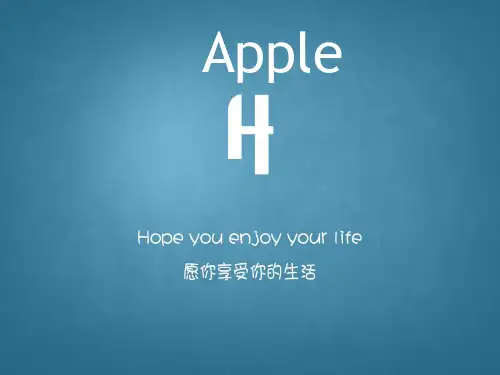
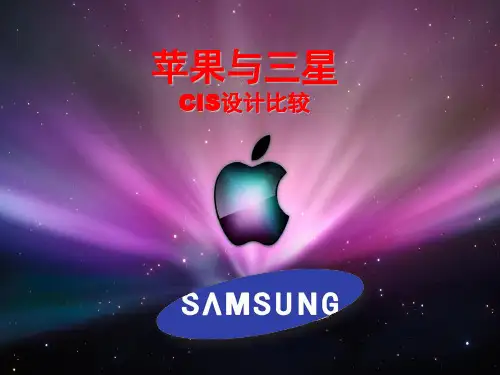
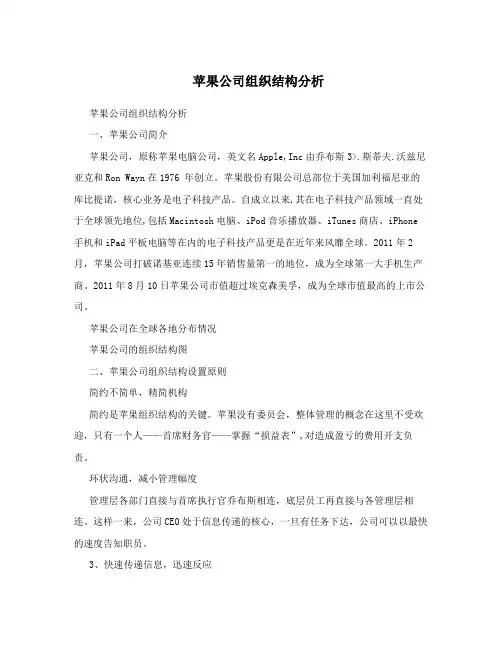
苹果公司组织结构分析苹果公司组织结构分析一、苹果公司简介苹果公司,原称苹果电脑公司,英文名Apple,Inc由乔布斯3>.斯蒂夫.沃兹尼亚克和Ron Wayn在1976 年创立。
苹果股份有限公司总部位于美国加利福尼亚的库比提诺,核心业务是电子科技产品。
自成立以来,其在电子科技产品领域一直处于全球领先地位,包括Macintosh电脑、iPod音乐播放器、iTunes商店、iPhone 手机和iPad平板电脑等在内的电子科技产品更是在近年来风靡全球。
2011年2月,苹果公司打破诺基亚连续15年销售量第一的地位,成为全球第一大手机生产商。
2011年8月10日苹果公司市值超过埃克森美孚,成为全球市值最高的上市公司。
苹果公司在全球各地分布情况苹果公司的组织结构图二、苹果公司组织结构设置原则简约不简单,精简机构简约是苹果组织结构的关键。
苹果没有委员会,整体管理的概念在这里不受欢迎,只有一个人——首席财务官——掌握“损益表”,对造成盈亏的费用开支负责。
环状沟通,减小管理幅度管理层各部门直接与首席执行官乔布斯相连,底层员工再直接与各管理层相连。
这样一来,公司CEO处于信息传递的核心,一旦有任务下达,公司可以以最快的速度告知职员。
3、快速传递信息,迅速反应对苹果来说,由于有着简约的组织结构,所以苹果这个庞大的公司能够迅速地采取行动和信息传递。
因人设职,权责分明苹果公司从来不把公司损益情况当做管理人员的业绩凭证,每个员工只用专注于自己的责任。
公司的每个员工的职责都分得非常清楚,正是这样使公司内部管理井井有条且充满活力。
因地制宜,分区管理苹果公司的市场庞大,采取分区管理更利于总部因地制宜。
为不同地区制定不同的管理方案等。
三、苹果公司组织结构的优点适应不稳定环境下的高度变化。
清晰的产品责任和联系环节以及迅捷的服务实现顾客满意。
跨职能的高度协调。
使各分部适应不同的产品,地区和顾客,从而提高顾客的满意程度。
决策分权。
苹果公司英文作文下载温馨提示:该文档是我店铺精心编制而成,希望大家下载以后,能够帮助大家解决实际的问题。
文档下载后可定制随意修改,请根据实际需要进行相应的调整和使用,谢谢!并且,本店铺为大家提供各种各样类型的实用资料,如教育随笔、日记赏析、句子摘抄、古诗大全、经典美文、话题作文、工作总结、词语解析、文案摘录、其他资料等等,如想了解不同资料格式和写法,敬请关注!Download tips: This document is carefully compiled by theeditor. I hope that after you download them,they can help yousolve practical problems. The document can be customized andmodified after downloading,please adjust and use it according toactual needs, thank you!In addition, our shop provides you with various types ofpractical materials,such as educational essays, diaryappreciation,sentence excerpts,ancient poems,classic articles,topic composition,work summary,word parsing,copyexcerpts,other materials and so on,want to know different data formats andwriting methods,please pay attention!Apple Inc. is a multinational technology company basedin Cupertino, California. It was founded by Steve Jobs, Steve Wozniak, and Ronald Wayne in 1976. The company is known for its innovative products, including the iPhone, iPad, Mac, and Apple Watch.Apple's products are widely popular around the world, and the company has a large and loyal customer base. The sleek design and user-friendly interface of Apple products have contributed to their success.In addition to hardware, Apple also offers a range of software and services, such as the App Store, iTunes, and iCloud. These services have further integrated Apple products into the daily lives of consumers.One of the key factors in Apple's success is its strong brand image. The company has built a reputation for quality, innovation, and customer service. This has helped Applemaintain a competitive edge in the technology industry.Apple has also been a leader in corporate social responsibility, with initiatives to reduce its environmental impact and improve working conditions in its supply chain. This commitment to sustainability has resonated with consumers and investors alike.Overall, Apple Inc. has had a significant impact on the technology industry and continues to be a dominant force in the market. With its focus on innovation, design, and customer experience, Apple is likely to remain a major player for years to come.。
Do you know why Apple with a bite of the apple as a company logo
Apple in Greek mythology, is the symbol of wisdom, when Adam and eve ate the apple became a thinking, now extended to the unknown fields of science and technology. Apple's logo is a bite of the apple, shows that they have the courage to march to science, to explore the unknown
苹果在希腊神话中,是智慧的象征,当初亚当和夏娃就是吃了苹果才变得有思想,现在引申为科技的未知领域。
苹果公司的标志是咬了一口的苹果,表明了他们勇于向科学进军,探索未知领域的理想Faster than the sum of its parts.
Advanced Intel Core i5 and i7 processors help you power through the most complicated technical computing tasks. Integrated Iris 6100 and Iris Pro Graphics and advanced AMD graphics give you tons of pixel-driving horsepower. State-of-the-art I/O like Thunderbolt 2 gives you high-performance expansion, unprecedented in a notebook. And at the centre of it all is an entirely flash storage–based architecture that makes everything you do incredibly fast and responsive.
先进的Intel Core i5 和i7 处理器,帮你从容应对极度复杂的技术性运算任务。
集成Iris 6100 和Iris Pro Graphics 图形处理器与先进的AMD 图形处理器,为每个像素都带来源源不断的强大驱动力。
Thunderbolt 2 等先进的I/O 传输技术,更赋予笔记本电脑前所未有的高性能扩展能力。
而这一切的核心,就是全闪存架构,它令你所做的一切都运转快速,响应灵敏。
Video Edition
Edit up to 10 streams of uncompressed 8-bit 1080p HD video on the 15-inch model —right from internal storage.Having four times the pixels of a standard display makes video so sharp, so clear and so lifelike, your shots may look even better than you remember.
15 英寸机型可直接从内部存储多机位剪辑多达
16 条1080p ProRes 视频流。
拥有4 倍于标准显示屏的像素,让视频如此锐利、清晰、而且鲜活动人,让你拍摄的每一个画面远胜记忆中的每一个精彩时刻。
Photography ith over four million pixels on the 13-inch model and over five million pixels on the 15-inch model, the Retina display is the perfect place to view and edit your high-resolution photos.
13 英寸机型的Retina 显示屏具有400 多万像素,15 英寸机型具有500 多万像素,是查看和编辑高分辨率照片的绝佳选择。
Design And Layout
The MacBook Pro is the ultimate creative design studio.
MacBook Pro 堪称强大的创意设计工作室Science And Engineering
Advanced dual-core and quad-core processors provide an enormous amount of computational power.
先进的双核和四核处理器,可为你提供源源不绝的澎湃运算能力。
Backlit Keyboard
Thin and light, MacBook Pro is designed to go anywhere — including places with less-than-stellar lighting. A built-in sensor detects changes in ambient light and adjusts the keyboard and display brightness automatically. So you’re never left in the dark.
这款轻薄的MacBook Pro 可以随你去到任何地方,包括光线难以企及的地方。
内置传感器会检测环境光的变化,然后自动调节键盘和显示亮度,让你不会迷失在黑暗之中。